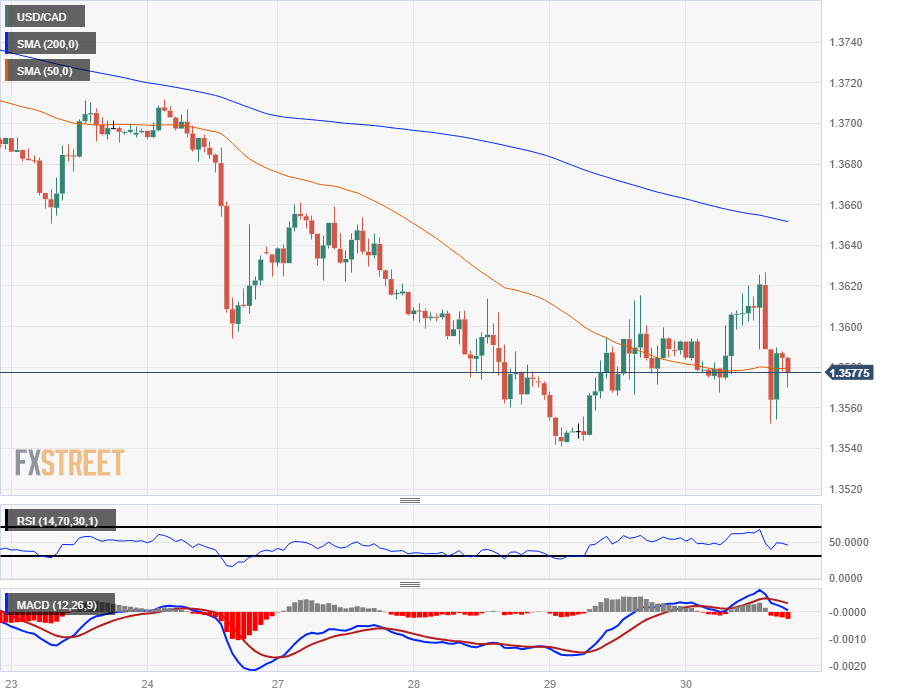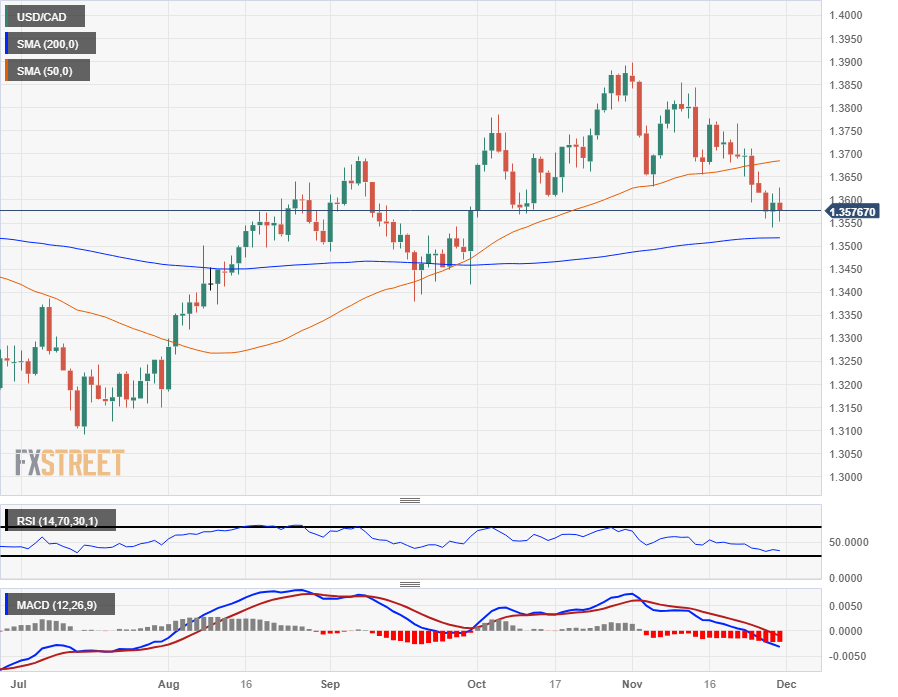- The Canadian Dollar saw a broad-market push higher on Thursday
- Canadian GDP mixed, but the underlying revisions are helping to bolster the CAD.
- OPEC supply cuts to prop up Crude Oil markets, underpin Loonie trading.
The Canadian Dollar (CAD) caught a batch of bids during Thursday’s US trading session, bolstered by an expected climb in Crude Oil on additional OPEC production cuts through the first quarter of 2024. The Canadian Dollar is the single best-performing of the major currency bloc, in the green against all of its major currency peers as the Loonie heads into the end of the Thursday trading day.
Canadian Gross Domestic Product (GDP) came in mixed but leaning positive in the near-term data, and Crude Oil is lending the fossil-fueled Loonie some support. The Organization of the Petroleum Exporting Countries (OPEC) unanimously agreed to additional production cuts with an ambiguous end date sometime next year.
Daily Digest Market Movers: Canadian Dollar makes a late topside break
- The Canadian Dollar caught a late surge on Thursday to outperform the rest major currency bloc.
- The CAD is up nearly a full percent against the Japanese Yen (JPY) and the Euro (EUR), and around seven-tenths of a percent on the Pound Sterling (GBP) at the time of writing.
- Canadian GDP came in mixed, with the September MoM printing 0.1% above the expected flat 0.0%, while the YoY figure contracted steeply.
- Annualized third quarter Canadian GDP came in at -1.1%, sharply missing the market median forecast of 0.2% YoY growth, but the previous period’s figure did see a sharp upward revision, getting adjusted from -0.2% to 1.4%.
- Crude Oil markets are set for an upside twist after OPEC unanimously agreed (for the time being) to further cut oil output by an additional million barrels per day (bpd).
- Crude Oil price gains on the back of additional supply cuts likely to remain capped with plenty of spare capacity in global energy demand.
- OPEC is reporting that the additional production caps will last through Q1 2024.
- Despite the CAD's overall strength, the Loonie is only up a scant 0.05% against the US Dollar.
- Friday brings Canadian labor data with the Canadian Unemployment Rate, forecast to tick up slightly from 5.7% to 5.8% in November.
Canadian Dollar price today
The table below shows the percentage change of Canadian Dollar (CAD) against listed major currencies today. Canadian Dollar was the strongest against the Japanese Yen.
| USD | EUR | GBP | CAD | AUD | JPY | NZD | CHF | |
| USD | 0.78% | 0.61% | -0.10% | 0.21% | 0.81% | 0.07% | 0.31% | |
| EUR | -0.78% | -0.18% | -0.88% | -0.56% | 0.04% | -0.72% | -0.49% | |
| GBP | -0.61% | 0.19% | -0.70% | -0.39% | 0.23% | -0.53% | -0.30% | |
| CAD | 0.11% | 0.89% | 0.71% | 0.32% | 0.92% | 0.17% | 0.41% | |
| AUD | -0.24% | 0.58% | 0.38% | -0.31% | 0.61% | -0.15% | 0.07% | |
| JPY | -0.82% | -0.05% | -0.24% | -0.93% | -0.62% | -0.77% | -0.52% | |
| NZD | -0.07% | 0.72% | 0.53% | -0.17% | 0.15% | 0.74% | 0.24% | |
| CHF | -0.28% | 0.50% | 0.31% | -0.40% | -0.08% | 0.52% | -0.23% |
The heat map shows percentage changes of major currencies against each other. The base currency is picked from the left column, while the quote currency is picked from the top row. For example, if you pick the Euro from the left column and move along the horizontal line to the Japanese Yen, the percentage change displayed in the box will represent EUR (base)/JPY (quote).
Technical Analysis: Canadian Dollar lurches higher on the day, sends the USD/CAD back below 1.3600
The Canadian Dollar (CAD) initially fell back against the US Dollar (USD) in Thursday trading with the pair reaching a three-day high of 1.3626, but the CAD’s late break sent the pair back below the 1.3600 handle to test the waters near 1.3550.
Intraday chart action continues to be capped by the 200-hour Simple Moving Average (SMA) descending into 1.3650 while the 50-day SMA is drawing prices into the near-term midrange around 1.3580.
Daily candlesticks have the USD/CAD pair struggling to make downside progress towards the 200-day SMA just above 1.3500, and the CAD is struggling to carve out further downside territory against the USD despite Thursday’s Loonie push.
USD/CAD Hourly Chart

USD/CAD Daily Chart

Canadian Dollar FAQs
What key factors drive the Canadian Dollar?
The key factors driving the Canadian Dollar (CAD) are the level of interest rates set by the Bank of Canada (BoC), the price of Oil, Canada’s largest export, the health of its economy, inflation and the Trade Balance, which is the difference between the value of Canada’s exports versus its imports. Other factors include market sentiment – whether investors are taking on more risky assets (risk-on) or seeking safe-havens (risk-off) – with risk-on being CAD-positive. As its largest trading partner, the health of the US economy is also a key factor influencing the Canadian Dollar.
How do the decisions of the Bank of Canada impact the Canadian Dollar?
The Bank of Canada (BoC) has a significant influence on the Canadian Dollar by setting the level of interest rates that banks can lend to one another. This influences the level of interest rates for everyone. The main goal of the BoC is to maintain inflation at 1-3% by adjusting interest rates up or down. Relatively higher interest rates tend to be positive for the CAD. The Bank of Canada can also use quantitative easing and tightening to influence credit conditions, with the former CAD-negative and the latter CAD-positive.
How does the price of Oil impact the Canadian Dollar?
The price of Oil is a key factor impacting the value of the Canadian Dollar. Petroleum is Canada’s biggest export, so Oil price tends to have an immediate impact on the CAD value. Generally, if Oil price rises CAD also goes up, as aggregate demand for the currency increases. The opposite is the case if the price of Oil falls. Higher Oil prices also tend to result in a greater likelihood of a positive Trade Balance, which is also supportive of the CAD.
How does inflation data impact the value of the Canadian Dollar?
While inflation had always traditionally been thought of as a negative factor for a currency since it lowers the value of money, the opposite has actually been the case in modern times with the relaxation of cross-border capital controls. Higher inflation tends to lead central banks to put up interest rates which attracts more capital inflows from global investors seeking a lucrative place to keep their money. This increases demand for the local currency, which in Canada’s case is the Canadian Dollar.
How does economic data influence the value of the Canadian Dollar?
Macroeconomic data releases gauge the health of the economy and can have an impact on the Canadian Dollar. Indicators such as GDP, Manufacturing and Services PMIs, employment, and consumer sentiment surveys can all influence the direction of the CAD. A strong economy is good for the Canadian Dollar. Not only does it attract more foreign investment but it may encourage the Bank of Canada to put up interest rates, leading to a stronger currency. If economic data is weak, however, the CAD is likely to fall.
Information on these pages contains forward-looking statements that involve risks and uncertainties. Markets and instruments profiled on this page are for informational purposes only and should not in any way come across as a recommendation to buy or sell in these assets. You should do your own thorough research before making any investment decisions. FXStreet does not in any way guarantee that this information is free from mistakes, errors, or material misstatements. It also does not guarantee that this information is of a timely nature. Investing in Open Markets involves a great deal of risk, including the loss of all or a portion of your investment, as well as emotional distress. All risks, losses and costs associated with investing, including total loss of principal, are your responsibility. The views and opinions expressed in this article are those of the authors and do not necessarily reflect the official policy or position of FXStreet nor its advertisers. The author will not be held responsible for information that is found at the end of links posted on this page.
If not otherwise explicitly mentioned in the body of the article, at the time of writing, the author has no position in any stock mentioned in this article and no business relationship with any company mentioned. The author has not received compensation for writing this article, other than from FXStreet.
FXStreet and the author do not provide personalized recommendations. The author makes no representations as to the accuracy, completeness, or suitability of this information. FXStreet and the author will not be liable for any errors, omissions or any losses, injuries or damages arising from this information and its display or use. Errors and omissions excepted.
The author and FXStreet are not registered investment advisors and nothing in this article is intended to be investment advice.
Recommended content
Editors’ Picks

EUR/USD bounces off 1.1300, Dollar turns red
After bottoming out near the 1.1300 region, EUR/USD now regains upside traction and advances to the 1.1370 area on the back of the ongoing knee-jerk in the US Dollar. Meanwhile, market participants continue to closely follow news surrounding the US-China trade war.

GBP/USD regains pace, retargets 1.3200
The now offered stance in the Greenback lends extra support to GBP/USD and sends the pair back to the vicinity of the 1.3200 hurdle, or multi-day highs, amid a generalised better tone in the risk-linked universe on Monday.

Gold trades with marked losses near $2,200
Gold seems to have met some daily contention around the $3,200 zone on Monday, coming under renewed downside pressure after hitting record highs near $3,250 earlier in the day, always amid alleviated trade concerns. Declining US yields, in the meantime, should keep the downside contained somehow.

Six Fundamentals for the Week: Tariffs, US Retail Sales and ECB stand out Premium
"Nobody is off the hook" – these words by US President Donald Trump keep markets focused on tariff policy. However, some hard data and the European Central Bank (ECB) decision will also keep things busy ahead of Good Friday.

Is a recession looming?
Wall Street skyrockets after Trump announces tariff delay. But gains remain limited as Trade War with China continues. Recession odds have eased, but investors remain fearful. The worst may not be over, deeper market wounds still possible.

The Best brokers to trade EUR/USD
SPONSORED Discover the top brokers for trading EUR/USD in 2025. Our list features brokers with competitive spreads, fast execution, and powerful platforms. Whether you're a beginner or an expert, find the right partner to navigate the dynamic Forex market.



